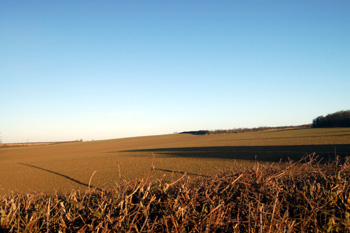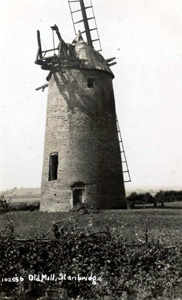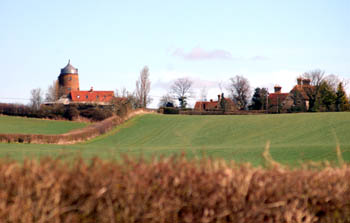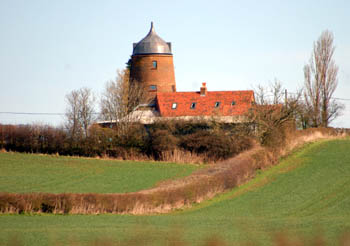
Looking from Mill Road to the site of the medieval windmill December 2008
Volume 14 published by Bedfordshire Historical Records Society, published in 1931, contained an article on Bedfordshire windmills by J. Steele Elliott. He quoted a large number of sources, none of them held by Bedfordshire & Luton Archives & Records Service, for the history of the mill dating from 1291 to 1678. In addition Bedfordshire & Luton Archives & Records Service has two early 17th century deeds as well as some 19th and 20th century sources. The site of this mill was some quarter of a mile east of the present 19th century mill.

Stanbridge Mill about 1930 [Z251/305]
The first reference, in 1291, was an inquisition into the goods and land of John de Gatesden, Lord of the Manor, in which: "The jurors say that the said John held in the vill of Stambridge, a messuage and two parts of a windmill, held of the king in chief by serjeantry". An inquisition into the land and goods of Richard Chamburleyn, Lord of the Manor, of 1439, which included "a certain site of a windmill which is worth two pence by the year". In 1601 a deed to lead to the uses of a fine saw the Manor conveyed by Richard Fowler, Lord of the Manor of Tilsworth and Richard Bennett of London, draper, to John Iremonger of Stanbridge, "freemason" [CH214]. The manor included a windmill in occupation of William Seer. On Iremonger's death in 1613 the windmill was included in the inquisition into his lands and goods. In 1623 the windmill and adjoining meadow called Mill Hill and Mill Baulk were used to secure the £400 portion of Jane, wife of John Iremonger's grandson, also called John [GA2669].

The Old Windmill and ridge March 2008
In 1662 William Iremonger of Ampthill, gentleman, assigned the manor including the windmill in trust to his uncles for his brothers and in 1678 the five brothers and sisters sold the manor, including the site "upon which a windmill did lately stand" to Ralph Baldwin of Ashwell [Hertfordshire] and Humberston Waller of London, grocer, for £400; clearly the old windmill was no more. Steele Elliott wrote of the site, in 1931: "The ancient mill stood on the opposite side of the road to the existing mill, and the trackway to it is still in evidence. The mill-mound is well defined on the hill top, and measures 6 feet across; it stands about 4 feet above the field level, and shows a slight depression in the centre".

The Old Windmill close-up March 2008
The Rating and valuation Act 1925 ordered every piece of land and building on the country to be assessed to determine the rates to be paid on it. The valuer visiting Stanbridge Mill [DV1/C97/95] noted that it was owned by the Misses Buckmaster and occupied by G.T.Heady. He simply noted: "brick and tile derelict windmill". Steele Elliott described it thus: "The tower is built of the narrow 2½ inch bricks. It stands 42 feet to the top of the crown, and measures 23 feet 6 inches over the base, with 24-inch brickwork. It is 40 years ago or more since it was last used, but even so, and notwithstanding its being in such an exposed position, it still carries the greater part of three of its sails, two of which carried shutters and two were for cloths. These had an overall stretch of 60 feet, and were 6 feet in width. It was worked with a fantail. There are four floors and two pairs of stones. The mill was built for William Twidell early in 1800, it passed to Christopher Buckmaster in the "thirties" and is now in the possession of his daughter Sarah Buckmaster, a maternal grand-daughter of the first-named; Benjamin Mead was miller in 1848...The mill ceased to work about 1885, William Symes being the last tenant miller".

The Old Windmill March 2008
The mill has lost its cap but has gained living accommodation attached. It is now a private house. It was listed by the former Department of Environment in 1952 as Grade II, of special interest. They agreed with J.Steele Elliott about the early 19th century date and simply noted: "Four storey red brick tower mill. Cap and gear have been removed. Now used as a private house".